The 5 best microchip cat flaps, tested and approved by real pet parents
We found the best microchip cat flaps to stop strays from entering your home
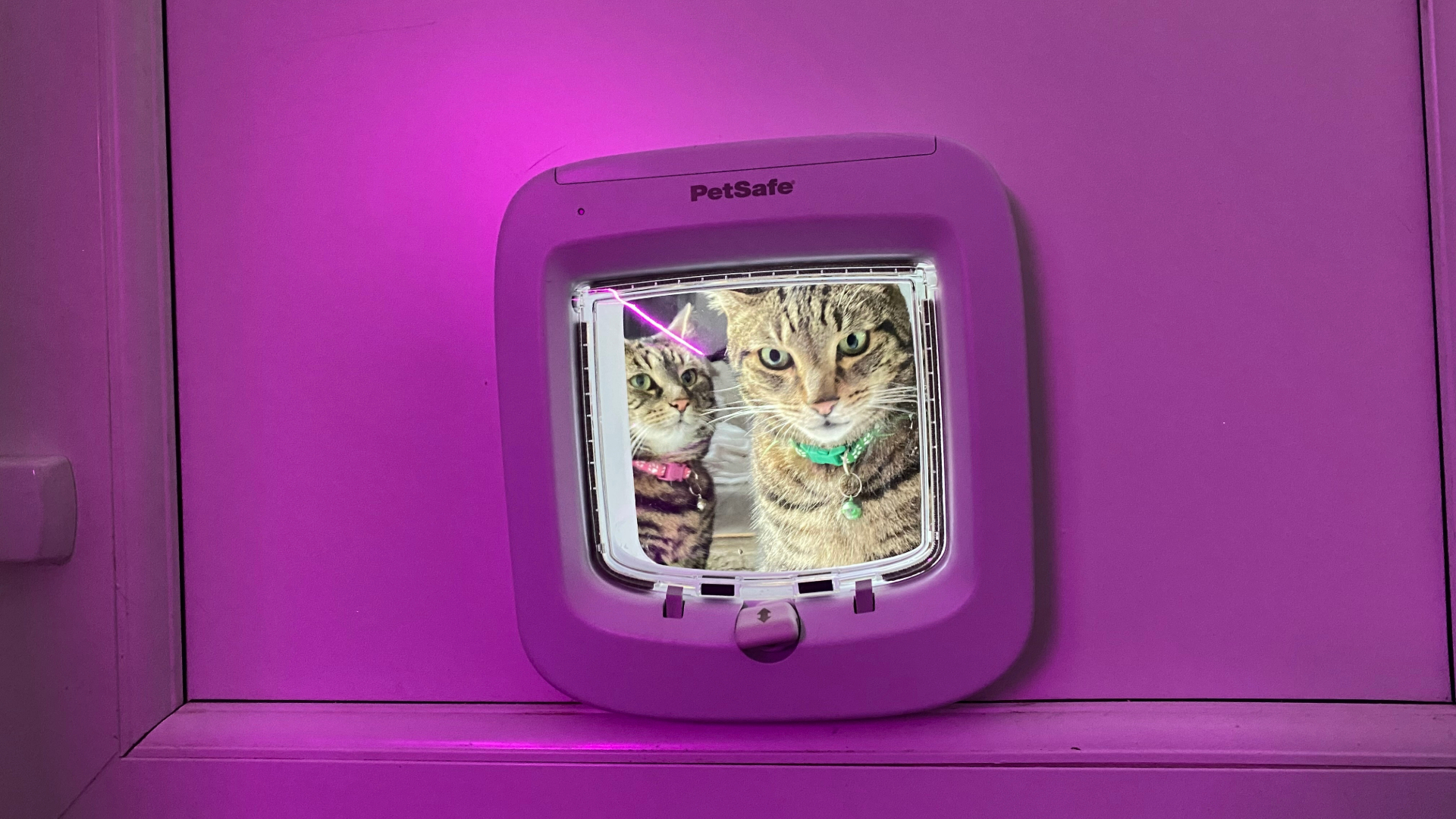
- Quick list
- 1. Best overall
- 2. Runner-up
- 3. Best for simplicity
- 4. Best with timer control
- 5. Best on a budget
- We also tested
- How we tested
- How to choose
- Do microchip cat flaps work?
- How long does a microchip cat flap work?
- Are they worth it?
- Should I microchip my cat?
- How it works
- How much do microchips cost?
- Do vets recommend microchip cat flaps?
There are lots of reasons why you should invest in the best microchip cat flap. Not only will it stop random cats from entering your home, but with some, you can even track your feline’s whereabouts. Both of these features are really helpful if you’re not always at home, and will give you peace of mind that your cat is safe and happy.
If a stray comes into your home, it can leave your cat feeling stressed, anxious and traumatized, according to cat behaviorist Amanda Campion. This is especially true if they start stealing the best cat food you’ve left out.
If you’re new to the world of microchip cat flaps and need a little guidance, you’ll want to keep on reading. We’ve tested five of the best options on the market, taking affordability, user experience, and functionality into consideration. Stick around to find out why I chose the SureFlap Microchip Cat Door Connect with Hub as my top pick.
The quick list
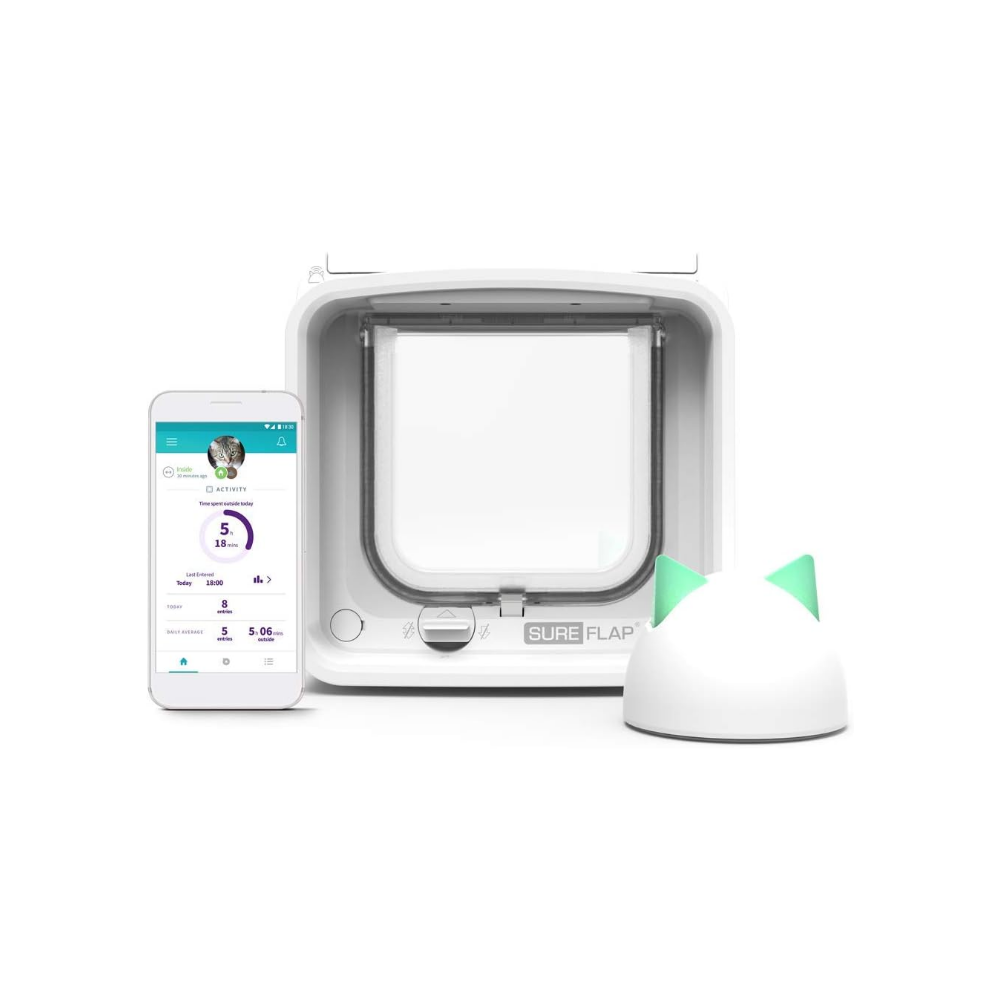
The best overall microchip cat flap
A clever cat flap that you can control remotely from your phone. If you want to monitor your cat's activity and set curfews, this one is for you. Plus, it's easier than you might think to install.
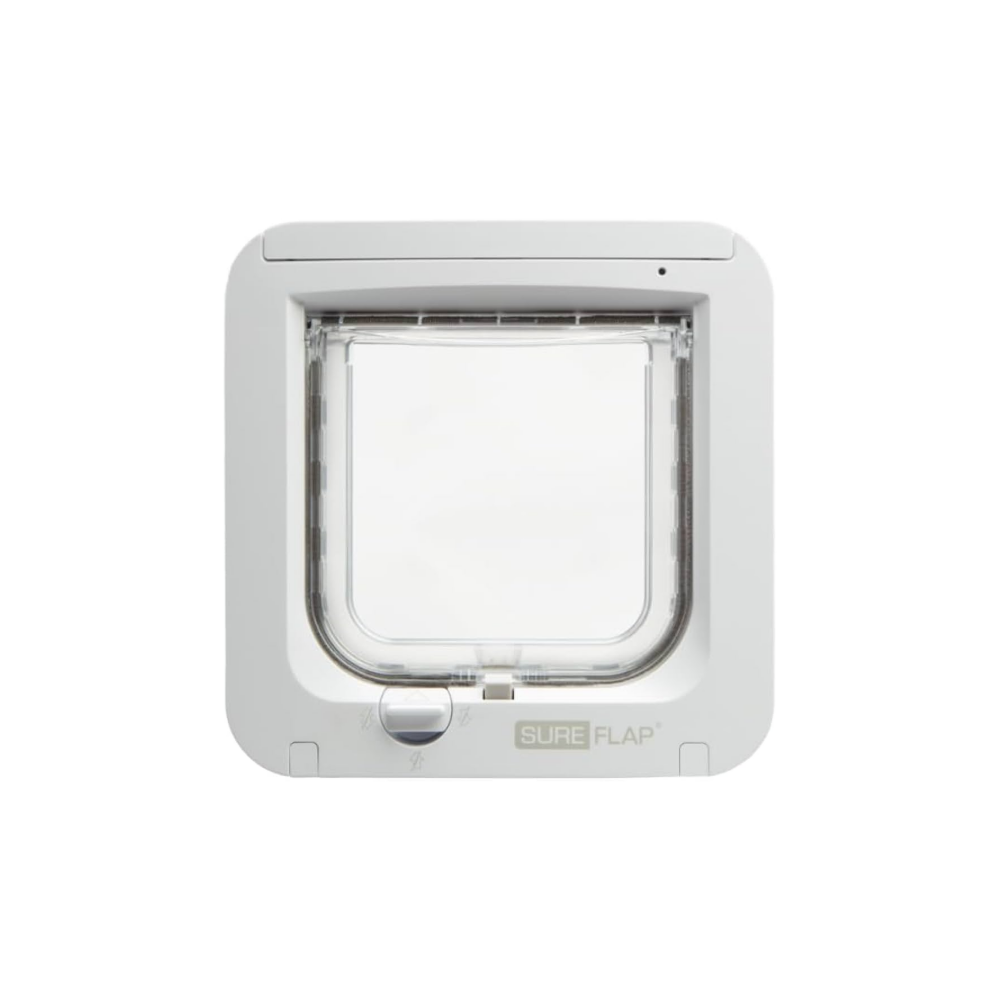
Runner-up microchip cat flap
When it comes to cat flaps, SureFlap knows what it's doing and this model is no exception. This design is easy to set up, simple to use, and gets the job done, keeping unwanted guests out of your home.
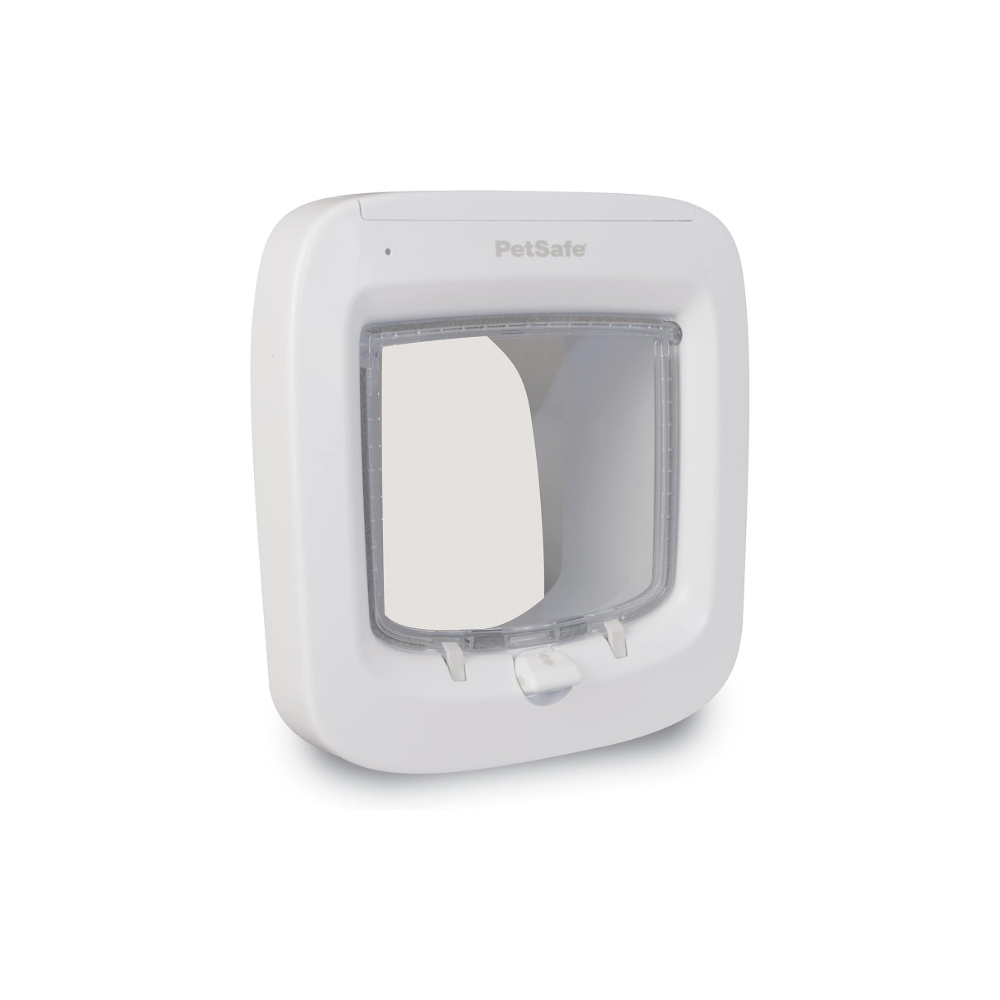
The best for simplicity
An budget-friendly cat flap that can register up to 40 cats per household. It's a piece of cake to install, thanks to the simple one-button programming.
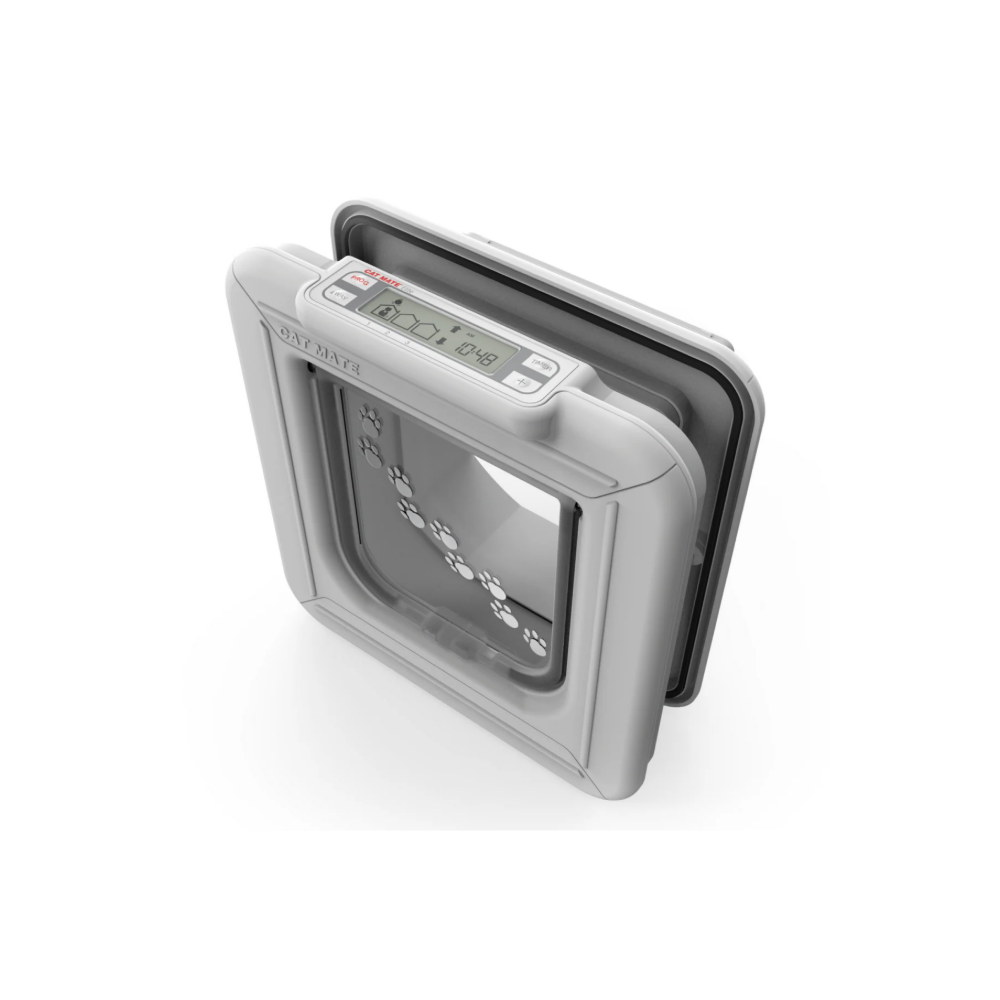
The best microchip cat flap with timer
A microchip cat flap that lets you set a curfew for your pet. This one's perfect for pet parents who want to give their furry friend independence, whilst having some control over their whereabouts and safety.
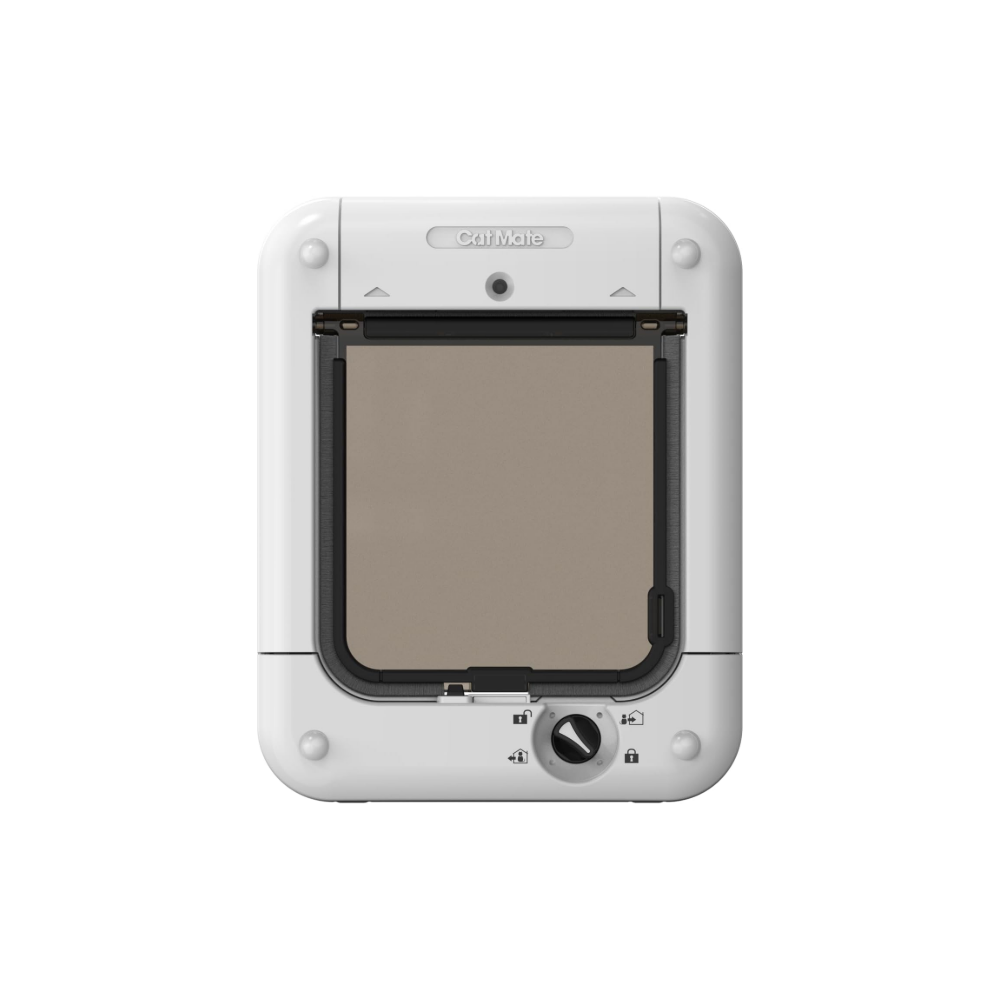
The best microchip cat flap on a budget
An energy efficient and affordable cat flap that will keep intruding strays out of your home. It's compatible with up to 30 cats and features a handy four-way manual locking system.
The best microchip cat flaps we recommend
Why you can trust PetsRadar
Best overall microchip cat flap

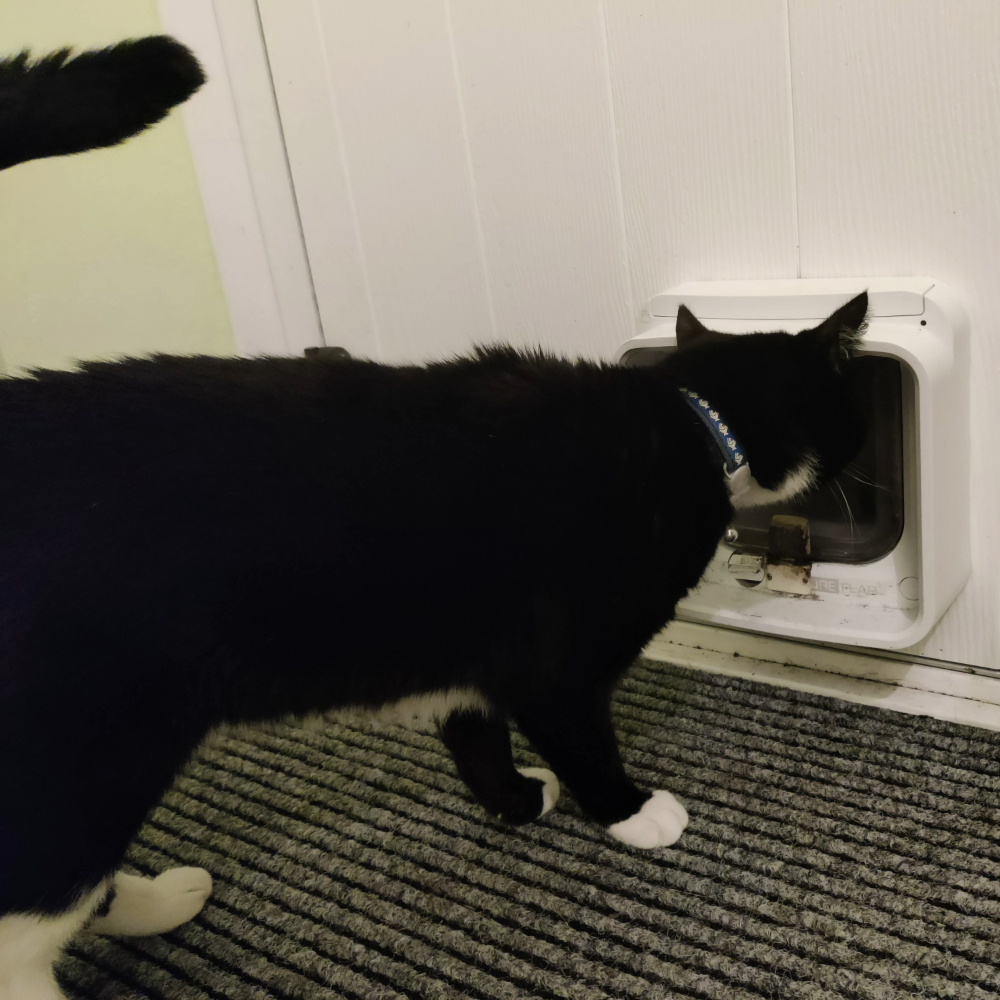
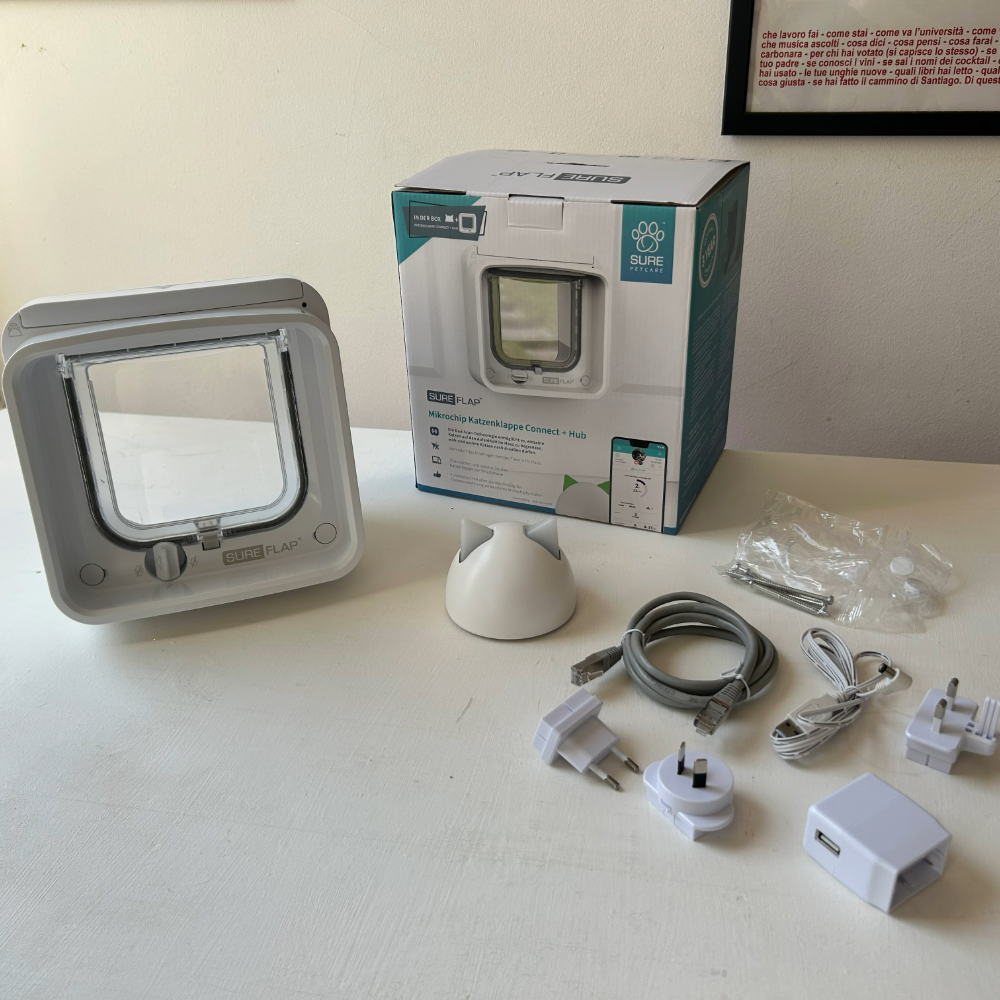

1. SureFlap Microchip Cat Door Connect with Hub Bundle
Our expert review:
Specifications
Reasons to buy
Reasons to avoid
It might not be the cheapest option on the market, but our tester Toby says the SureFlap Microchip Cat Door Connect with Hub is well worth the money.
You can control the cat flap from anywhere in the world; all you have to do is connect it to an app. This includes setting curfews, remotely locking and unlocking, getting notifications of your cat's whereabouts, and of course, stopping intruders coming in your home. Toby says these features are all "reassuring".
With so many features, you might be under the impression that it's hard to install, but Toby confirms that this isn't the case.
He says: "Setup was very simple. There's a paper guide for the cut holes to make, it fits tightly with little draft, and setting up the cats is just a case of putting them on one side, pushing a button, and coaxing them through the flap with some treats. The Connect app is simple enough and can have multiple users, allowing notifications for cats coming/going and changing curfew times, etc."
Toby also notes that you can select which cats get access outside and which ones do not – perfect for when cats need to stay inside due to things like medical issues. He's also linked his cat flap to his Home Assistant [a home automation system]. This allows him to set up other automations, like turning the lights on and off when he wants to know his cat is home for his medication.
He says: "We had a small issue with one of our cats learning how to ‘break out’ by picking the lock mechanism, but SureFlap provided a free replacement door panel that had a 3D-printed lip over the latch which stopped that happening ever again."
You can register up to 32 cats per household and share app access with other people. It's compatible with all common microchips or their RFID collar (bought separately on Amazon). If you're not sure if your cat's will work, you can check on their website. If you're thinking of installing it in glass, you'll need to buy their adaptor separately.
Runner-up microchip cat flap

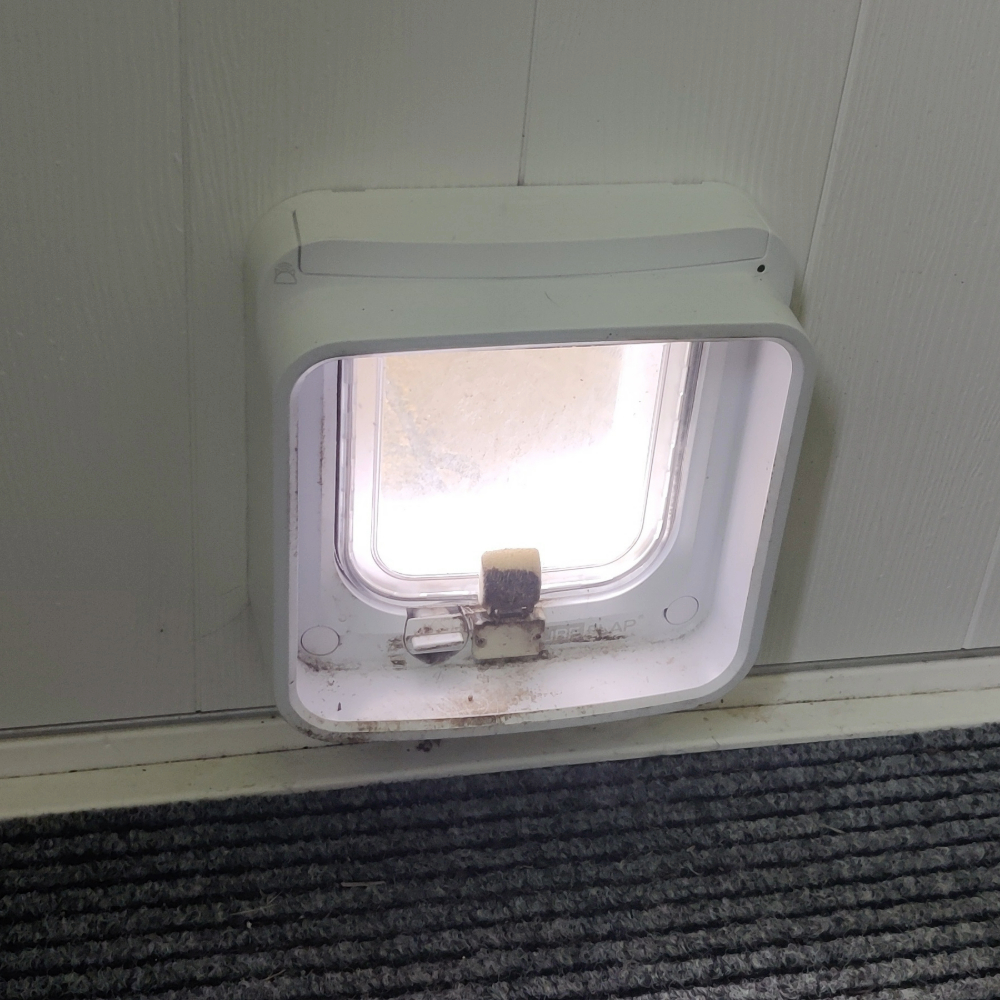
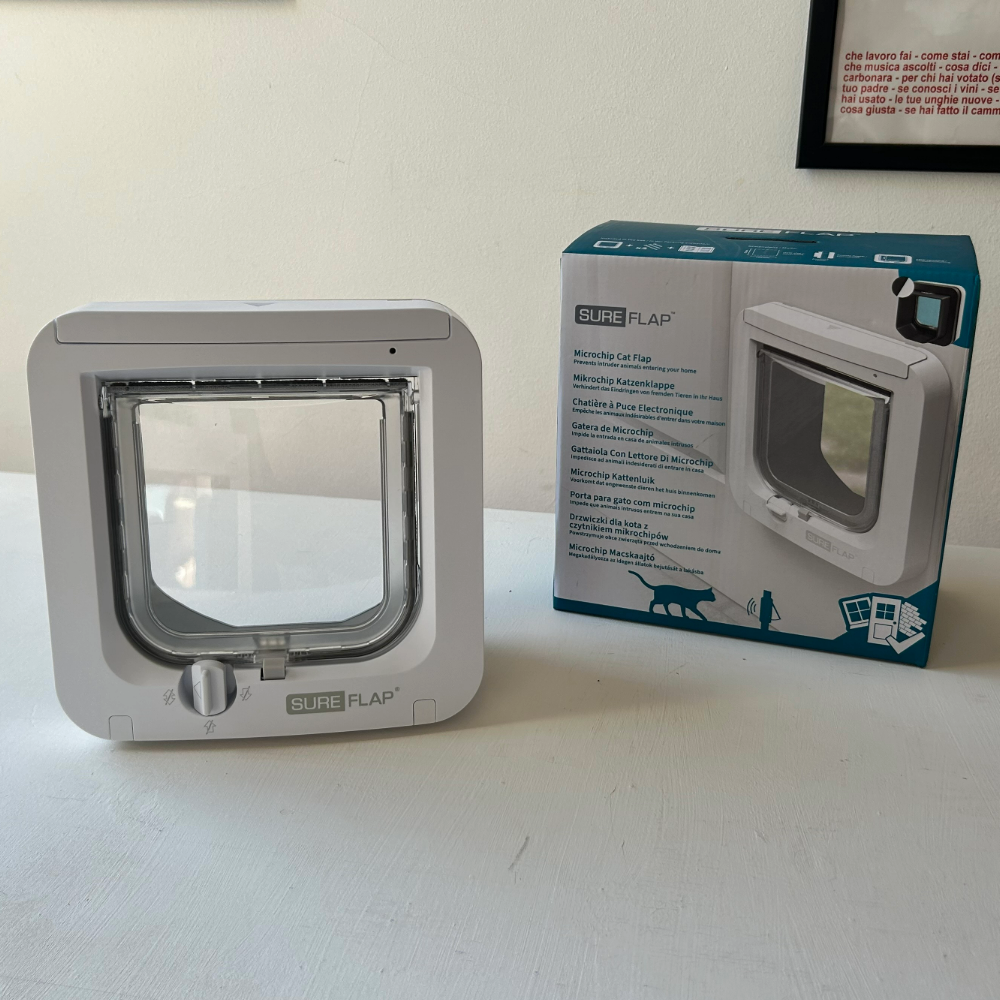
2. SureFlap Microchip Cat Flap
Our expert review:
Specifications
Reasons to buy
Reasons to avoid
Our tester Toby tried out the SureFlap Microchip Cat Flap, which he describes in three words as "reliable, robust and simple".
Toby says it's easy to use and very simple – to register a cat, you just need to push a button and coax them through the cat flap with some treats. The device can store up to 32 different cats, and even if you take out the batteries, it will still remember every pet.
The cat flap comes with a paper template to give you a helping hand with cutting the doors. However, if you're thinking of installing it in glass or a metal door, you'll need to buy their mounting adaptor separately (available on Amazon). And if it's going in a wall, you'll need their tunnel extender (also available on Amazon).
Toby says: "It works great, [I] had some issues with the lock mechanism being popped off by our cat, but [it] was replaced half a dozen times by SureFlap without any questions (and their newer models reportedly fixed the issue entirely)."
You'll need four AA batteries to get started and when the charge starts to run low, you'll be notified with a flashing light. Toby says it's easy to clean as it's smooth plastic.
So, how does it weigh up against the SureFlap Microchip Cat Door Connect with Hub that Toby also tested?
He says: "If you want automatic curfews, or clarity on your pets' activities and controlling their movement for the purpose of medicines etc, the smarter one is the way to go. Otherwise, the standard microchip one is great – as long as you don't mind cats coming in/out all the time or manually locking it."
This one is compatible with all common identification microchips or the RFID collar tag (which can be bought separately on Amazon).
Best microchip cat flap for simplicity

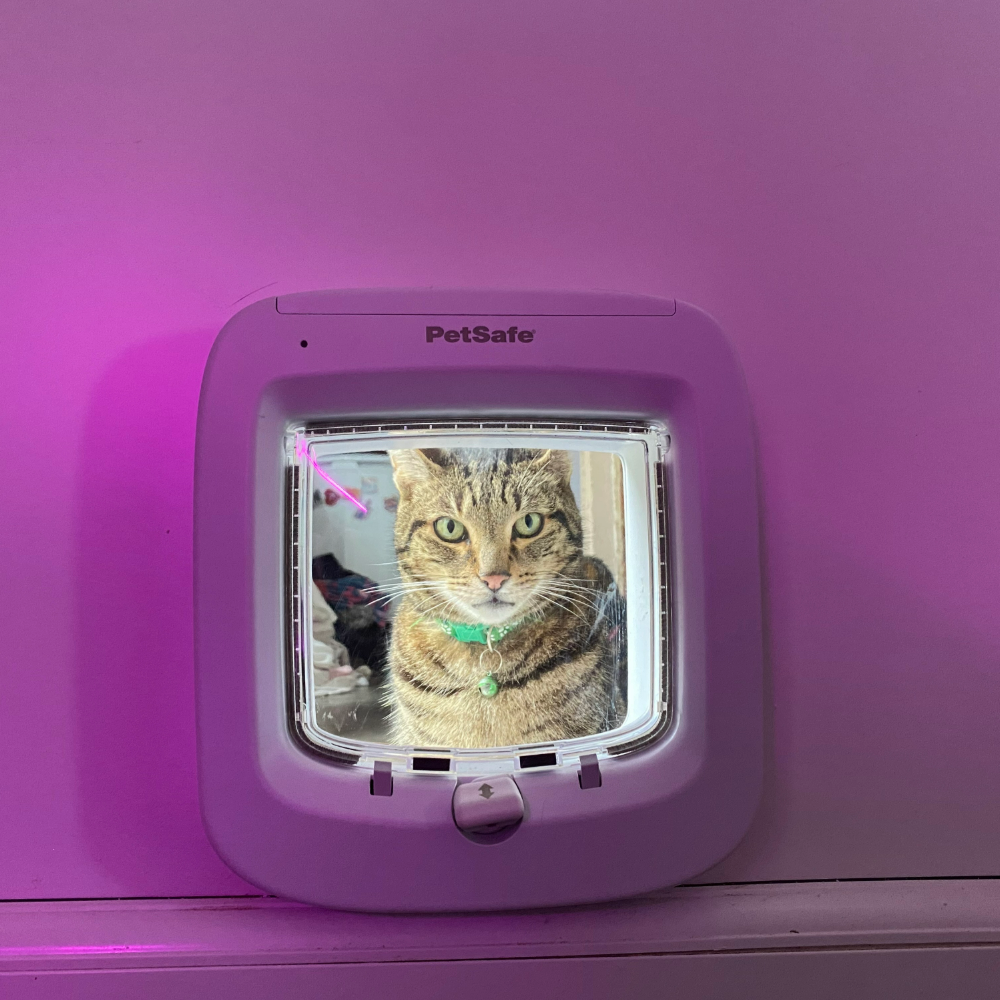
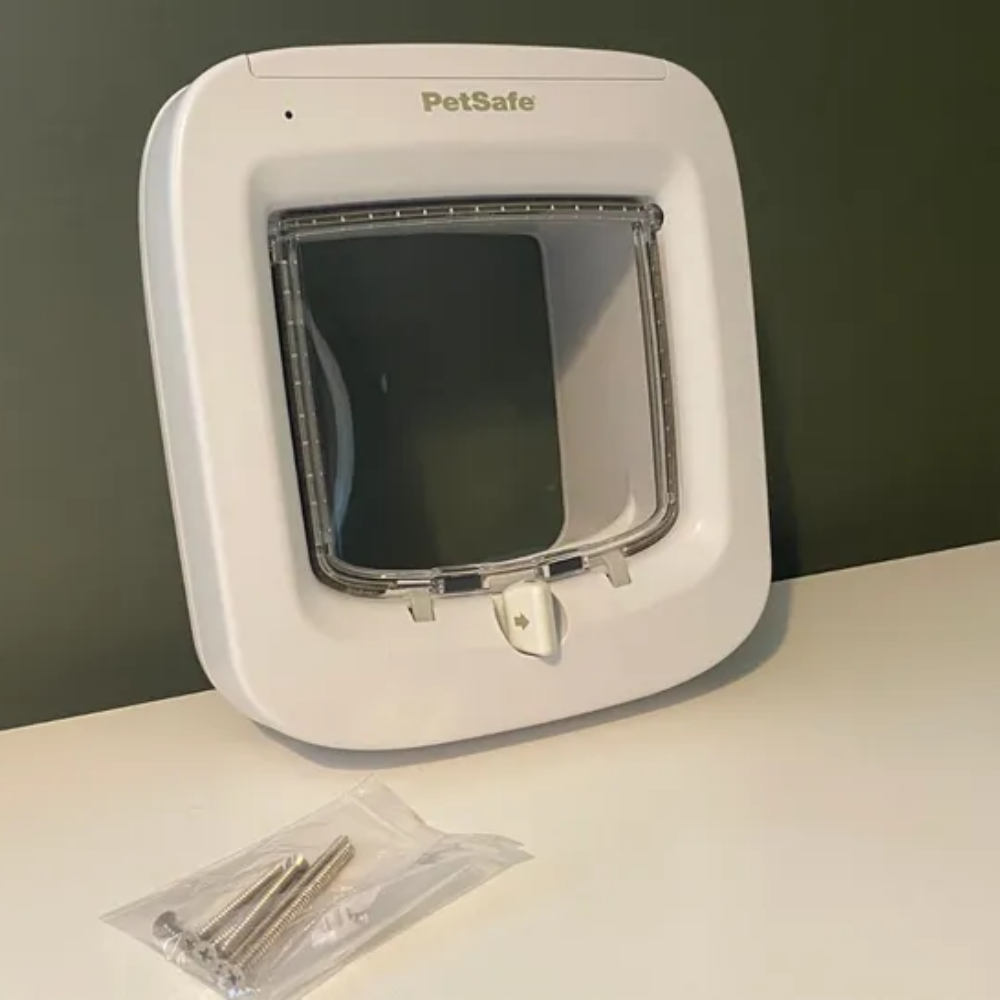
3. PetSafe 4-Way Locking Microchip Entry Cat Door
Our expert review:
Specifications
Reasons to buy
Reasons to avoid
I've grown up with cats all my life, so I'm very familiar with stray cats entering the house (and the chaos that unfolds afterward). I've been woken up countless times to the sound of screeching in the kitchen at 3am so when I found out a microchip cat flap could put a stop to this, I was overjoyed.
This PetSafe option features a four-way manual locking system and can register up to 40 cats per home (a girl can dream). Not only was it super easy to install but it also features two magnetic closing points to help keep the draught out. This makes it a great energy efficient option, something that's important to most people (including myself). It's also one of the cheapest options in this guide, proof that you don't need to spend the most to get results.
I was pleasantly surprised at just how easy it was to connect to my cat's microchip. I simply held down the button for five seconds, popped her head through and it was good to go. As someone who hates reading instructions, I can vouch for these – they were simple to follow, clear to read, and didn't require 100 fiddly steps.
However, if you want to install it onto a metal door, you'll need to buy an installation adaptor separately (these are around $15 on Amazon). The same goes for walls or double-glazed glass. It's compatible with 15-digit microchip numbers (FDX-B, 977 and 985), as well as the PetSafe Microchip Cat Door Key which can be attached to the collar.
Nala the cat was a little cautious of the cat flap at first (like she is with everything) and it took her a few tries to get used to it. But the cat flap does what it says on the tin and opens every time for her, just as promised.
You'll need four AA batteries to get started, and the cat flap will flash every 10 seconds if it's running low on charge. This means you'll have plenty of time to replace the batteries and your furry friend won't be left in the cold!
This model is pretty similar to the SureFlap Microchip Cat Flap, except from the slightly larger dimensions and a lower price point.
Best microchip cat flap with timer control


4. Cat Mate Elite Microchip Cat Flap with Timer Control
Our expert review:
Specifications
Reasons to buy
Reasons to avoid
If you want a bit more control over your cat flap (without downloading yet another app), then the Cat Mate Elite Microchip Cat Flap with Timer Control is for you.
This model features an LCD screen that shows you whether your cat is in or out, the lock status, and the last time the door was used. For the latter, it can do this for up to three cats. If you're lucky enough to own more than 10 cats, you'll want to pick another model (like the SureFlap Microchip Cat Door Connect with Hub Bundle) because this has a limit of nine registrations.
The cat flap is compatible with nine, 10, and 15-digit microchips, as well as the Cat Mate ID Discs, which can be bought separately on Amazon. You'll be pleased to hear that it's draught- and weather-proof, thanks to the magnetic closure and sealed flap. If you're hoping to install this in a wall, it's worth noting that you'll need to buy the Cat Mate Elite Wall Liners separately, but these cost less than $15.
It only took me five minutes and a few easy steps to program the cat flap to the ID disk. The setup was really simple and the instructions weren’t difficult to follow. You need four AA batteries to turn it on, which are a little difficult to put in but should last you a year. I struggled to connect it to my cat’s microchips, but the ID disc worked fine and easily clipped onto their collar (it even had space to write my contact details on).
The timer control allows you to set a curfew for your cat – something that will definitely come in handy for my cats, Nala and Chilli! One thing to keep in mind is that your cat needs to press their head onto the flap for it to open, which might take a little while for them to get used to.
Best microchip cat flap on a budget

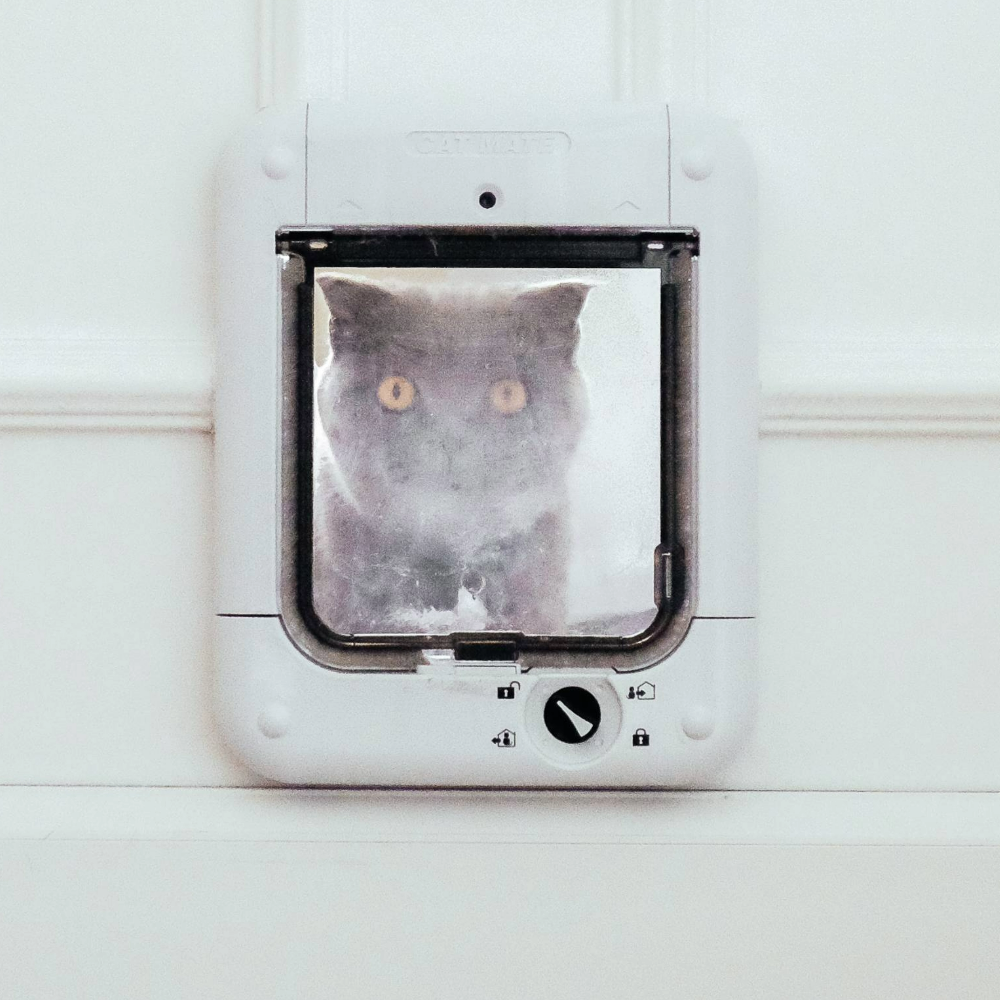
5. Cat Mate Microchip Cat Door
Our expert review:
Specifications
Reasons to buy
Reasons to avoid
Microchip cat flaps can get a little pricey, especially if you're opting for one with high-tech features. If you're looking for something that's low-key and a bit more affordable, then the Cat Mate Microchip Cat Door could be a good option for you.
You can register up to 30 cats on the device and the four-way lock system means you have total control over your cats going in and out. This model is a great energy-efficient option, due to the magnetic closure and fluffy weather-stripping insulation. For those who want to install a cat flap into walls or glass panels, you'll need to buy their adaptor separately, which costs $28.50.
It's compatible with 15-digit ISO, and nine and 10-digit AVID microchips, but you can buy their ID disk collar if your furry friend isn't microchipped. You’ll need four AA batteries to get started, which should last you a whole year before you need to replace them.
This cat flap is simple to set up and has clear instructions to follow. While I couldn’t get it to work with my cats’ microchips, it’s easily connected to Cat Mate’s collars and opens quickly when your cat presses their head into the flap.
It might not have any fancy features, like the remote-controlled app on the SureFlap Microchip Cat Door Connect with Hub Bundle, but it’s a great no-frills option if you’ve never tried one before.
Other cat flaps to consider
Lessmon Cat Door
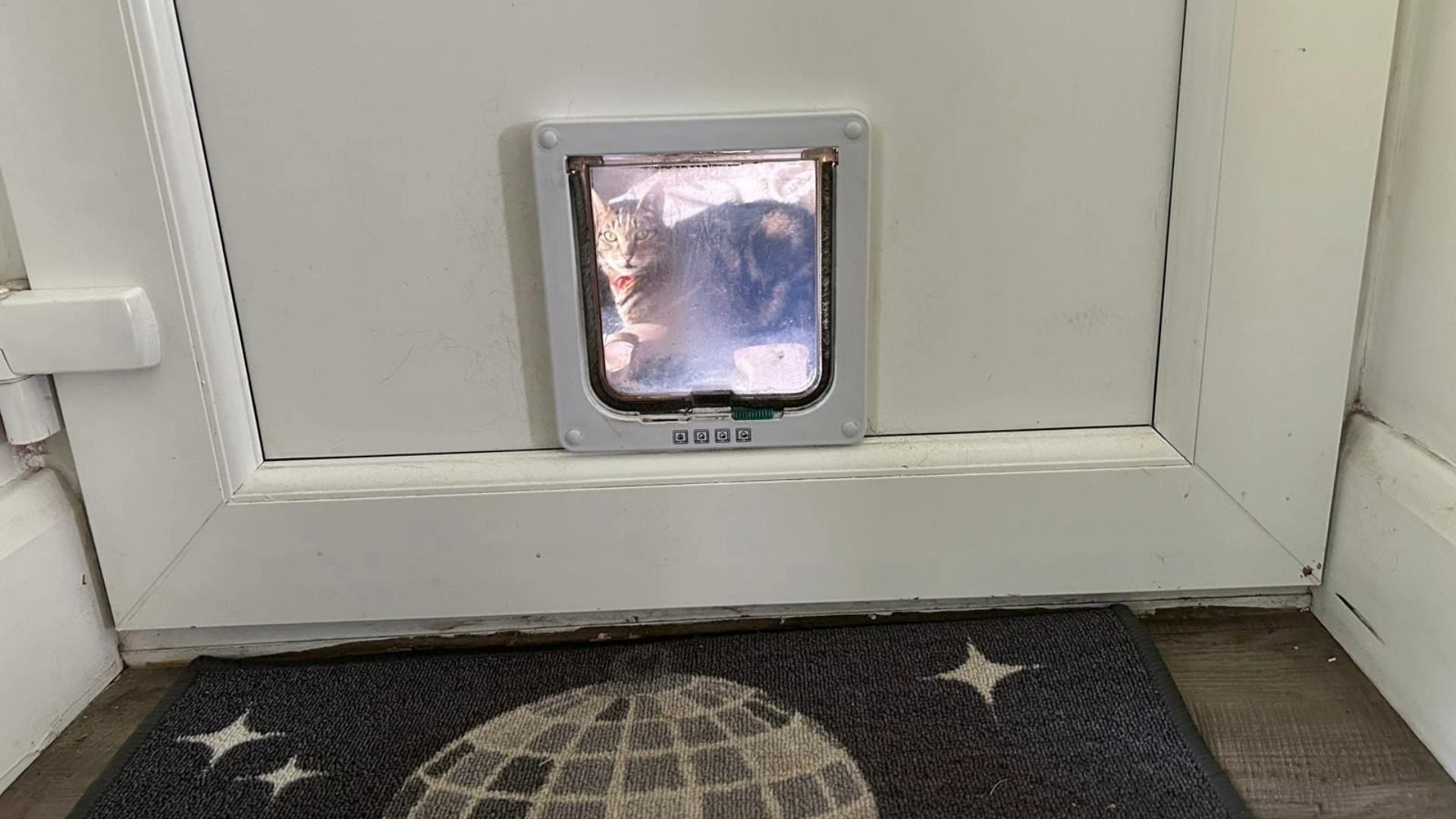
If you're looking for something more affordable, the Lessmon Cat Door is a trusty option that we've had in our house for years. While it doesn't have the microchip feature – or the ability to monitor your cat's activity – it provides easy access for your cats, was simple to install, and costs under $12.
How we tested the best microchip cat flap
Microchip cat flaps tend to be a little more pricy than traditional ones, so we understand you want to get it right. To save you from wasting your money, we selected high-quality cat flaps on the market and put them to the test on real cat owners. We took into consideration the following factors:
1. Value for money
Everyone deserves the best microchip cat flap, which is why we tried to include a range of price points to make it more accessible.
2. Setup
No one has time to spend hours figuring out how to use a cat flap, which is why set-up was a very important testing factor. We can confirm that all of the cat flaps in this guide are easy to use with a simple set-up.
The last thing you want is to buy a cat flap and not be able to use it, which is why we've let you know if you need any additional things to get started (like an app or adaptor). This means you won't have any surprises when it comes to setting it up. If you've never set one up before, here's how to install a pet door in nine easy steps.
3. Additional features
Whether it connects to an app or has a timer control, we've highlighted all of the great features on these cat flaps. But for those who just want something simple, we included some more basic options too.
4. Microchip
We also considered which microchips the cat flaps are compatible with and whether an alternative collar can be used instead.
5. Fit for purpose
While everything above is super important, the most crucial factor is whether your cats actually want to use it. We tested these products out on our own feline friends to see how easy it was for them to use.
If you're spending money on a new device, you want it to work effectively, so we ensured each product does what it says on the tin and opens when they try to get through.
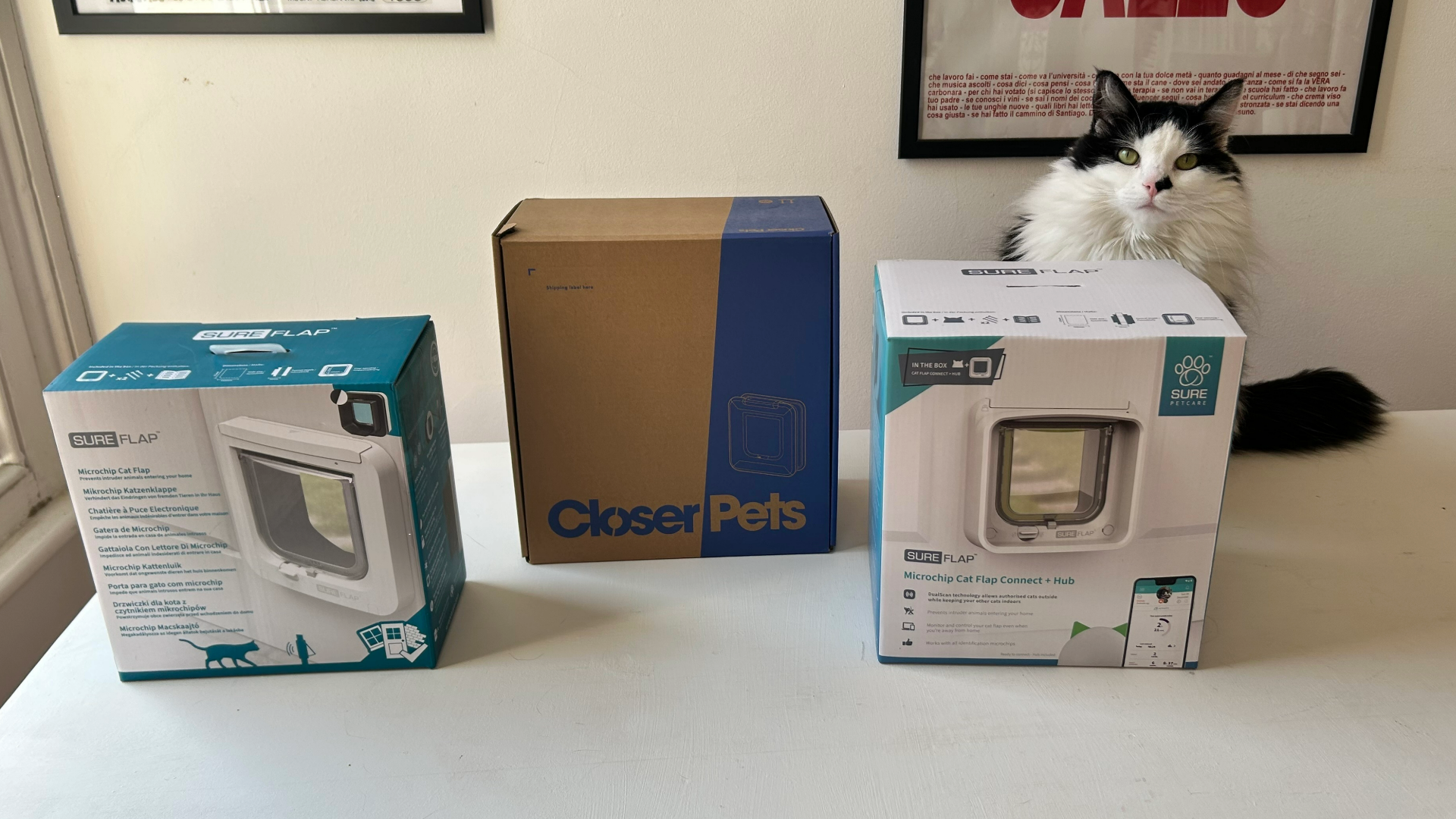
For additional information, read our dedicated page on how we test.
Meet our review panel

Toby Jackson, Tester
Toby Jackson tested the SureFlap Microchip Cat Door Connect with Hub and SureFlap Microchip Cat Door with his cat Banjo (pictured).

Megan Milstead, Staff Writer
Megan tested the PetSafe 4-Way Locking Microchip Entry Cat Door, Cat Mate Elite Microchip Cat Flap with Timer Control and Cat Mate Microchip Cat Door with her cats Nala (pictured), Chilli, Polpetta and Tofu.
How to choose the best microchip cat flap
Not sure where to start when thinking about microchip cat flap specifications? Start here…
1. Power source
You can either have an external power source for the cat flap, or it can be battery powered. There are pros and cons to each – but batteries are often considered better overall as it gives you maximum flexibility over where to place the flap, there’s no chance of creating trip hazards with wires, and they’ll keep working even if the power supply is otherwise interrupted.
If you do decide to go for a battery-powered cat flap, you might want to look for one that offers an indicator as to when the battery is running low so you can recharge or replace the batteries.
2. Size of cat
You’ll need to make sure that whatever cat flap you buy fits your feline friend with ease. This might sound obvious, but it’s worth double-checking the size of the aperture against the size of your cat, particularly if yours is on the large side.
You’ll also need to think about whether the flap is suitably sized for where you intend to install it – such as a back door. Some will need extra accessories or adapters around the flap, which should be taken into account too.
3. Weather resistance
If you live somewhere that is prone to lots of rain or snow, you should also look for flaps that promise to withstand tough weather conditions.
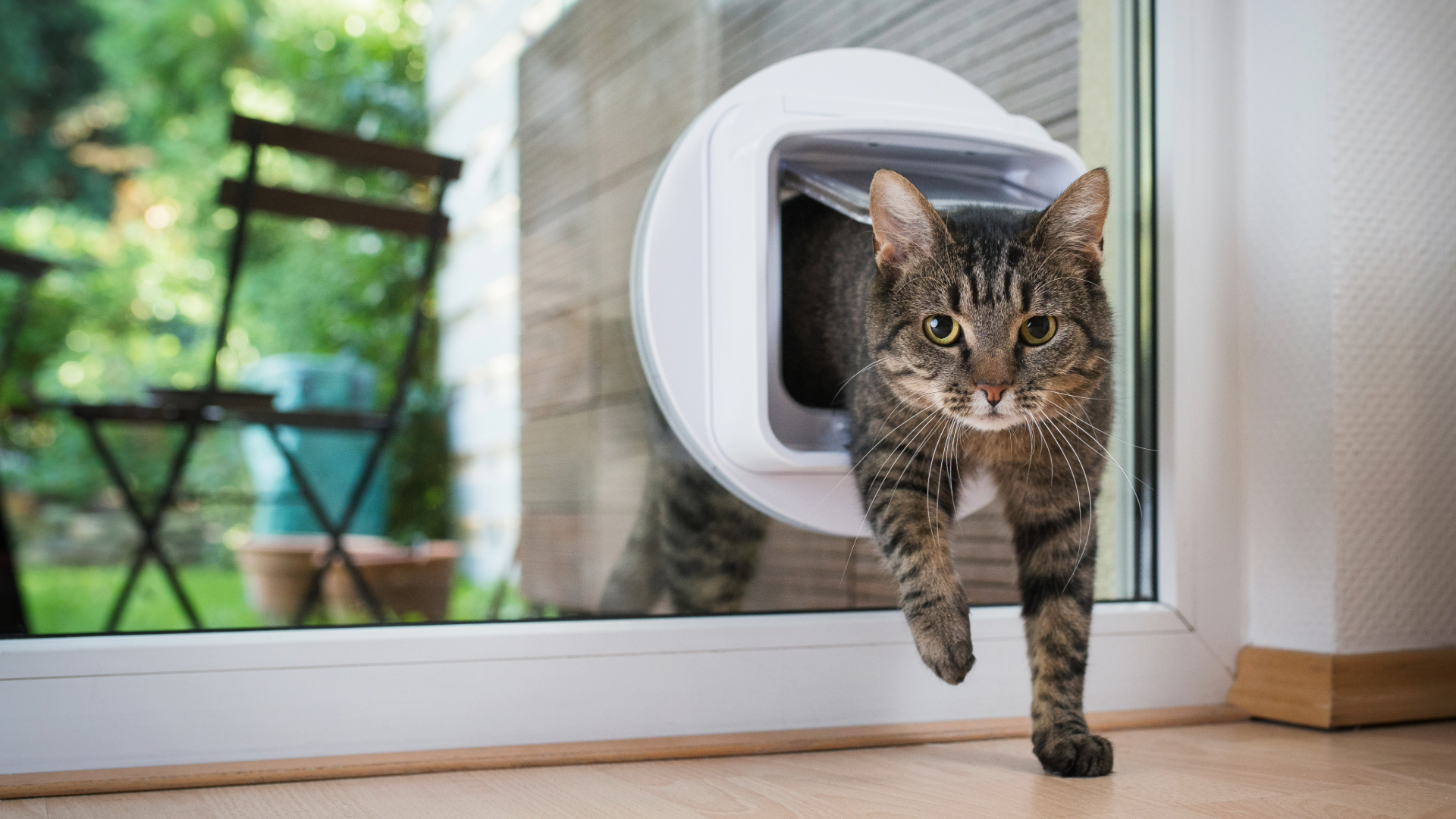
4. Energy efficiency
If your cat flap is placed on a door that leads directly into a main living space, you might want to think about its weather-sealing, to keep draughts and breezes out and ensure you’re not losing valuable energy from your home.
This might be slightly less important if your cat flap is placed somewhere like a porch or external area, but it’s always worth thinking about the best ways to keep the heat in. Some devices use things like a triple-flap setup to ensure there’s never a direct airflow from outside to inside.
5. Number of cats
If you’ve got more than one cat, you’ll need to make sure you pick a flap that can recognize multiple moggies. Most of them can do this, but, if you have cats with different needs – such as ones that shouldn’t be let out after a certain time – you’ll also need to check whether or not you can set specific rules for specific cats.
If you're still feeling stuck, here's a quick comparison of all the microchip cat flaps we've tested:
Model | Price | Special features |
$300/£266 | Microchip activated, app-controlled, set timers and curfews, activity notifications, dual-scan, four-way lock control, low battery indicator | |
$186/£70 | Microchip activated, four-way lock, low battery indicator | |
$106/£73 | Microchip activated, four-way lock, low battery indicator, draught excluder | |
$100/£80 | Microchip activated, four-way lock, draught excluder, LCD display, set timers | |
$88/£50 | Microchip activated, four-way lock, draught excluder |
Do microchip cat flaps work?
Simple answer? Yes, they do. Once you have set them up – and assuming the batteries have not run out – these cat flaps will recognize your moggies by reading the microchip implanted into their neck, thereby allowing the little door to open. The flap should then close behind your cat and not allow any other felines with an unrecognizable chip to enter, giving a feline peace of mind.
There is, however, one way an intruder cat may be able to get in: by tailgating. This is rather unavoidable because a neighborhood cat can easily get up close to your feline's bottom and seize the opportunity to enter while the flap is still fully open. Another animal could also place a sneaky paw within an open door to prevent it from closing again.
One thing's for sure, the microchip cat flap isn't going to forcibly push a tailgating cat back but such incidents are going to be rare. In most cases, once a flap has closed again, it will lock within seconds. It's also worth pointing out that a microchip cat flap won't stop your moggy from voluntarily bringing in small animals, alive or dead, either.
If you want to learn more, read our expert's guide on how microchip cat flaps work.
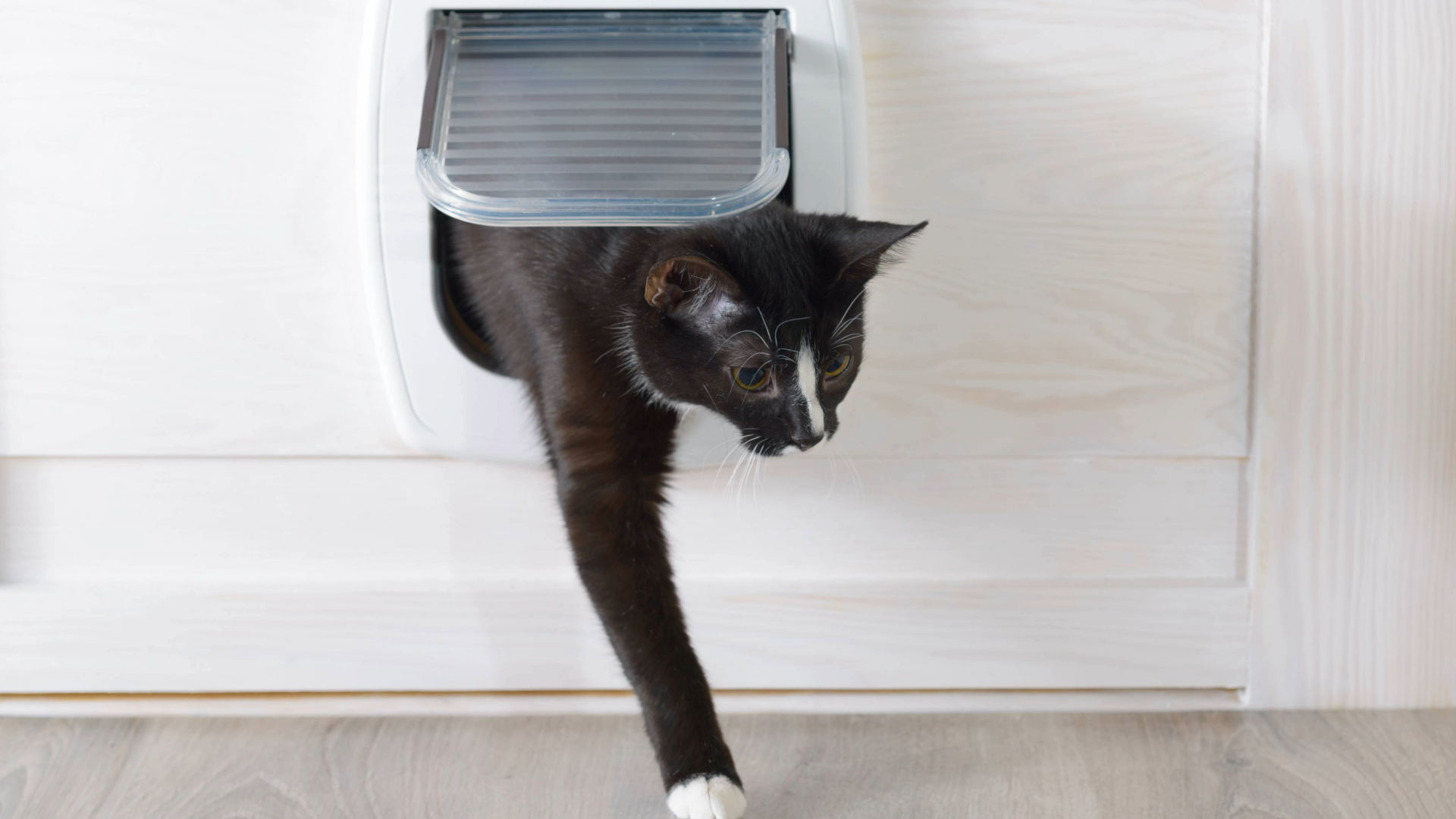
How long does a microchip cat flap work?
The microchip cat flap itself should last for years – it's the batteries that will fail first. Not to worry, though, because they're easily replaceable and, if you opt for rechargeable ones, they're not going to be especially costly or inconvenient in the long run either.
The good news is that the microchip inside your cat should last for a lifetime. They are inserted into your cat by a vet and they are not known to fail or break.
Is it worth getting a microchip cat flap?
Cat flaps provide such great assistance as you know your cat can come and go even if you are not there. No more worrying about them being left outside if it starts to rain for example. But they also have a disadvantage in that every roaming feline can use them too and often they do!
To counter this magnetic cat flaps appeared but these types can ruin the cat collar rapidly and then they won’t work. Enter the microchip cat flap… which resolves all these issues and some you didn't realize you needed such as allowing some of your cats in and out but not others, they also prevent wildlife like foxes from coming into your house. Overall yes they are worth it even if they do cost a little more time and money in the setup.
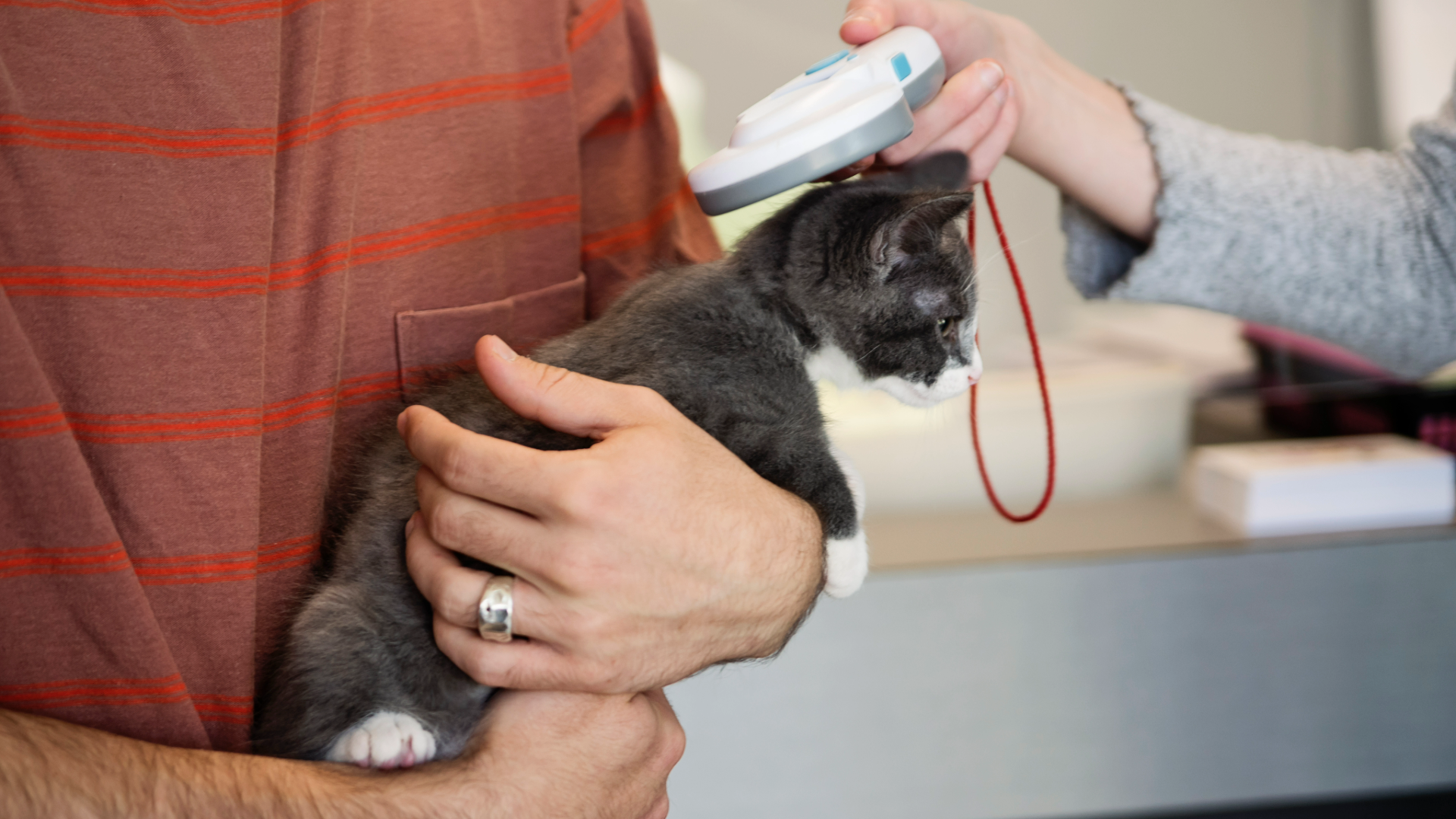
Should I microchip my cat?
If you haven't microchipped your cat, you might be wondering if you need to.
Amanda says: "Microchipping offers numerous benefits for cats and their owners. Firstly, it provides a reliable method of identification, enabling lost or stray cats to be reunited with their parents swiftly. This can alleviate the stress and worry associated with losing a beloved pet and increase the likelihood of a happy reunion.
"Secondly, microchipping helps deter pet theft and illegal breeding by establishing legal ownership and traceability of cats. Additionally, it promotes responsible pet ownership by encouraging owners to update their contact information regularly, ensuring accurate identification and contact in case of emergencies."
How does a cat flap recognize a microchip?
Microchip cat flaps are built with a sensor that uses radio frequency identification, and most devices can save up to 30 different microchip numbers. When a cat approaches the door, it reads their chip to see if it matches the ones saved.
Amanda says: “Microchip cat flaps use a cat’s unique microchip ID to control access, ensuring that only authorized pets can enter or exit the home. This feature prevents unwanted intruders, enhances safety, and provides peace of mind for pet parents.
“In some cases, the human parents do not even realize that the neighboring farm cat is entering the home in search of food or worse still, an intact female with whom to mate. Once a cat has had a negative experience like this in their safe space, it can take months to reverse the stress caused, so prevention is always the best option.”
“Furthermore, microchip cat flaps can be programmed to restrict access during certain hours, preventing cats from roaming at night or during specific times of the day. This capability allows cat parents to maintain control over their cat’s outdoor activities while still providing the freedom and enrichment they need for optimal mental health."
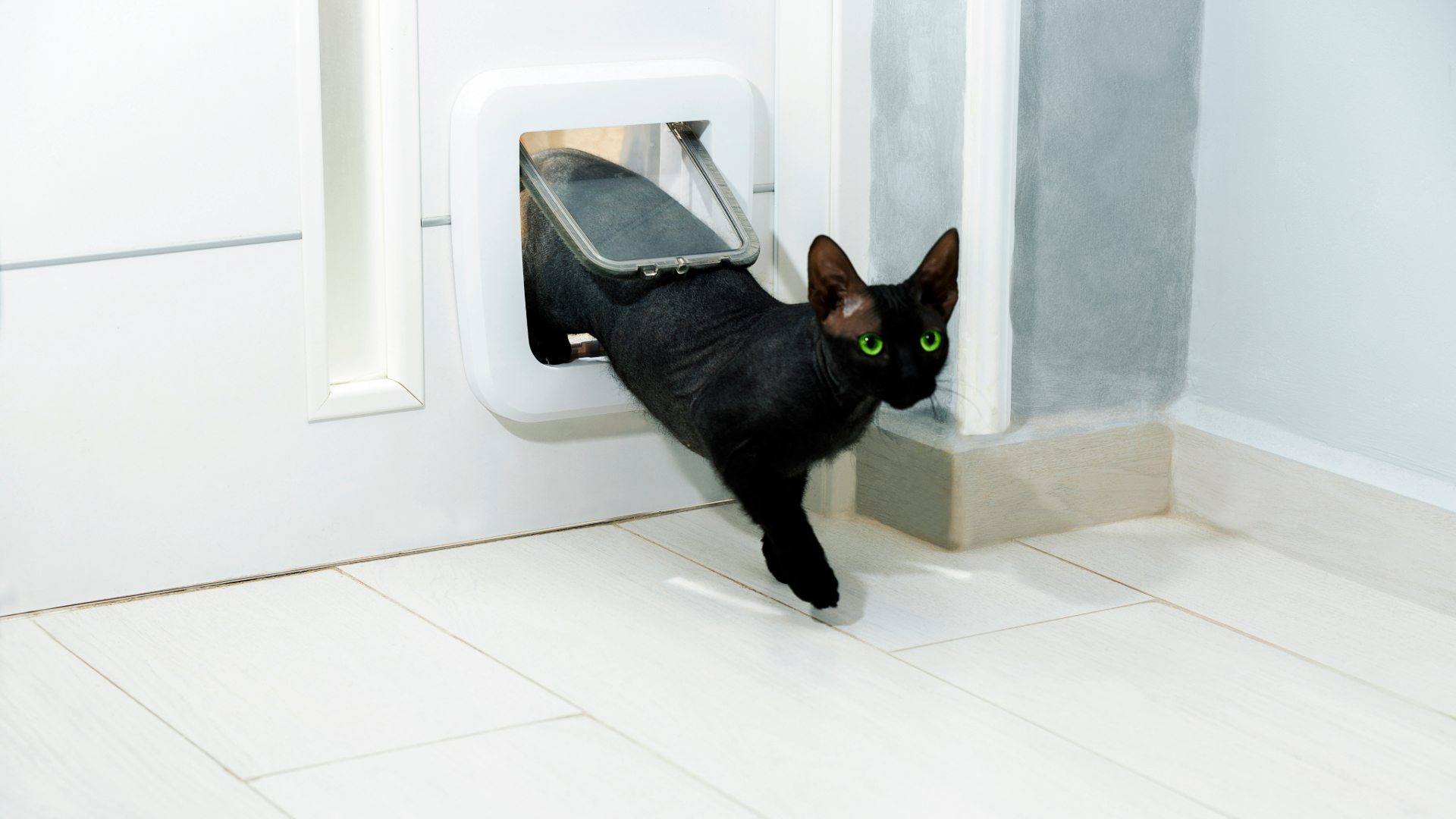
How much do microchips cost?
Every vet will have their own price, depending on the practice and location, but most are reasonable to encourage pet parents to get their cats microchipped.
Expert vet Dr. Rebecca MacMillan says: "In the UK, you can expect to pay between somewhere £10–30. Some will say it’s a small price worth paying to increase the chances of being reunited with a missing pet! Not to mention that it is now a legal requirement in some countries."
In the US, it costs around $50–70.
Do vets recommend microchip cat flaps?
Do vets recommend microchip cat flaps? We asked one to find out!
Dr. MacMillan: "Vets often recommend microchip cat flaps to owners, particularly if they are struggling with strays or neighboring cats entering their homes.
“This can create stress a lot of stress for the cat that lives there, contributing to behavioral issues, stress-induced cystitis, and overgrooming. It also stops intruding cats from being able to eat your pet’s food or from leaving any of their parasites behind.
"If you want to allow your cat access outside but want to stop other cats coming in, then a microchip cat flap is a good answer. Just make sure that you check it regularly to ensure it is functioning OK."
Read next: How to train a cat to use a cat door, how far do cats roam, and the best cat door alternatives

Megan Milstead is Staff Writer on PetsRadar and has been an animal lover for as long as she can remember. As a cat mom, she knows what it's like to have strays enter the home and understands the stress it can put on your pets. That's why she's committed to finding you the very best microchip cat flap. She's been on the team since 2023 and has a degree in Journalism from the University of Westminster. She's currently completing a course on cats and dogs, run by the University of Edinburgh.
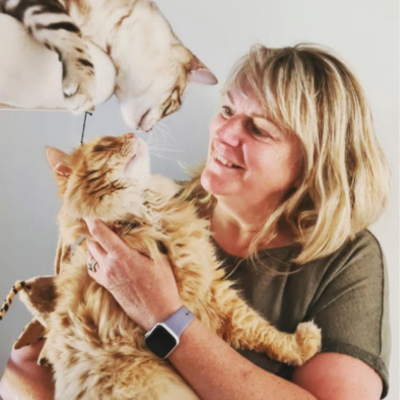
Practicing as a full clinical animal behaviorist member, Amanda's passion is cats – feral to feline show champion – helping to correct all their quirky unwanted issues, anxiety, and stresses that can manifest from time to time. Amanda has worked alongside charities for many years, helping rehabilitate cats from surrender and euthanasia. She previously had her own cattery, fostering and rehabilitating traumatized shelter cats, enabling them to go in to have happy lives with their new owners. She loves engaging with the cat caregivers and deciphering what problems they are having, as well as using her detective skills to find out what the cats’ problems are. As a CAB, she assists with a wide range of feline behaviors but the most rewarding to her is to see a previously traumatized or anxious cat start to trust again which is life-changing for the cat.
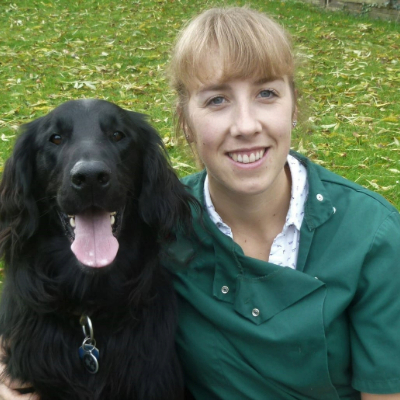
Rebecca is a veterinary surgeon who graduated in 2009 from the Royal Veterinary College in London. She has a wealth of experience in first opinion small animal practice, having done a mixture of day-to-day routine work, on-call emergency duties and managerial roles over the years. Rebecca enjoys medicine in particular and she is proud to have recently achieved a BSAVA postgraduate certificate in small animal medicine (with commendation).
Edited by Georgia Guerin and Alexis de Leaver.
We regularly review our buying guides to ensure the products are relevant, available and up to date. This page was last updated in May 2025 by Megan Milstead.
Get the best advice, tips and top tech for your beloved Pets

Megan is a Staff Writer at PetsRadar, covering features, reviews, deals, and buying guides. She has a wealth of experience caring for animals, having grown up with dogs, cats, horses, guinea pigs, and more throughout her life. She studied BA Journalism at the University of Westminster, where she specialized in lifestyle journalism and was editor of Smoke Radio’s lifestyle website. Megan works alongside qualified vets and accredited trainers to ensure you get the best advice possible. She is passionate about finding accurate and helpful answers to your pet-related questions.
- Amanda CampionClinical Feline Behaviorist
- Dr. Rebecca MacMillanVet
